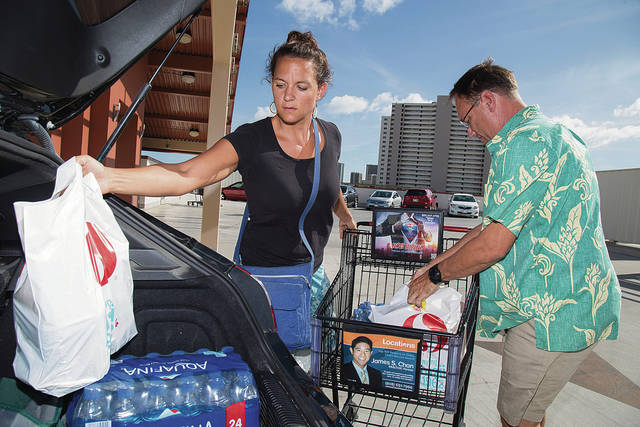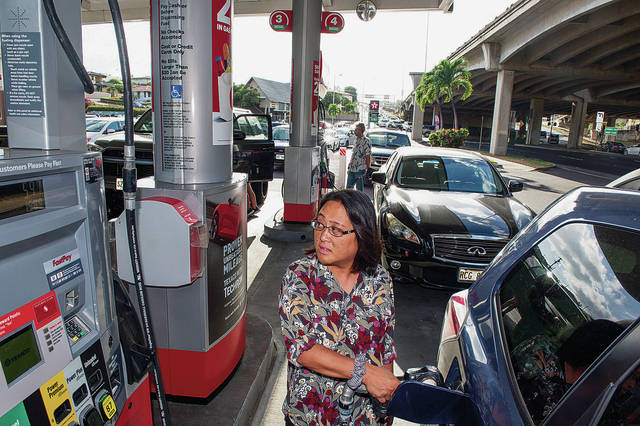Hawaii residents ready for the worst from Hurricane Lane


KAT WADE / SPECIAL TO THE STAR-ADVERTISER
Olivia Malcolm and David Hunter loaded their car with groceries and water they purchased at Safeway on Kapahulu Avenue.

CRAIG T. KOJIMA / CKOJIMA@STARADVERTISER.COM
Motorists lined up to fill their vehicles at the Texaco gas station on Waialae Avenue.



Hurricane preparedness just got real.
Costco Hawaii Kai shoppers wiped out 21 pallets of water in 20 minutes just before 6 p.m. Tuesday.
So one woman emptied the vending machine, buying all the bottled water, a clerk said.
A Costco employee promised more water would be available today.
At Yamashiro Building Supply in Kaneohe, several patrons were buying plywood for the first time.
Sharon Sakai, 71, of Kaneohe purchased plastic sheeting and two 4-by-8-foot boards, “in case I need it for picture windows and skylights.”
Don't miss out on what's happening!
Stay in touch with breaking news, as it happens, conveniently in your email inbox. It's FREE!
Related stories:
• Hurricane Lane takes a turn toward the islands Opens in a new tab
• Visitor industry says it’s ready Opens in a new tab
• Residents ready for the worst Opens in a new tab
• Health care providers ready contingencies Opens in a new tab
• Hurricane prompts harbor closure warnings Opens in a new tab
• Pearl Harbor girds for Lane Opens in a new tab
• Big Island and Maui County schools and universities to shut Wednesday Opens in a new tab
• Closures planned around incoming bad weather Opens in a new tab
• Communication providers prepare services for hurricane Opens in a new tab
• All Maui County, Big Island public schools to close Wednesday due to hurricane Opens in a new tab
• Gov. Ige signs emergency proclamation in advance of Lane’s arrival Opens in a new tab
• Arizona Memorial boat tours suspended due to Hurricane Lane Opens in a new tab
• Facebook Live: Gov. David Ige gives an update on Hurricane Lane Opens in a new tab
• Hurricane Lane postpones public school athletic events, after-school activities Opens in a new tab
• Hurricane warning issued for Big Isle; Oahu and Maui County under hurricane watch Opens in a new tab
• City releases extensive ‘Hurricane and tropical storm preparedness’ guide Opens in a new tab
• State Department of Transportation preparing for Hurricane Lane Opens in a new tab
• Honolulu mayor urges residents, tourists to track Hurricane Lane’s progress Opens in a new tab
• How to pack a disaster preparedness kit Opens in a new tab
Related photo galleries:
• Photos of residents preparing for the arrival of Hurricane Lane Opens in a new tab
“Thought about getting it in the past, but this time I thought I should have it on hand,” she said, adding that her son would be putting it up. “Hopefully, we won’t need it.”
But she wasn’t sure how to secure it to her windows. “We’ll tackle it when the time comes,” she said.
Renter Eli Ponimoi, 34, was sizing up the price for half-inch plywood and decided to go with the three-eighths-inch.
Hawaii Kai resident Chris Daniel, 50, opted for duct tape from Costco.
“They say anytime there’s an emergency, you should get it. Plywood? That’s too hard for me to do. If you’re not strong enough, you have to use tape and pray.”
She said the flooding during the April 13 rain event at her grandmother’s Aina Haina home taught her to be prepared for anything.
“We got everything else at home,” she said. “Since the April 13 flood, we tried to stock up. It doesn’t have to be a hurricane. Everything’s flooded when the stream gets backed up.”
A 60-year-old Kaneohe man bought hurricane clips for his 50-plus-year-old house, which wasn’t 100 percent secured.
Paul Wilson of Laie, with his wife and five children at Costco, piled high a shopping cart and a flatbed cart with six cases of water, peanut butter, tuna, nuts, refried beans and toilet paper.
“We don’t want our children to go hungry,” he said. They were prepared for two weeks. “If it hits, which we hope it doesn’t, we have a lot of little mouths.”
Micah Torres, 30, of Kaneohe said he tried to go to the City Mill in Kaneohe, but “you can’t get in and out of the horseshoe,” referring to the parking lot, and Kahuhipa Street fronting the store was backed up in both directions.
He, like several others, lined up to fill their propane tanks at Yamashiro’s, which sold 2,700 gallons of propane by 4 p.m. Tuesday. It sold out of crank-operated radios and propane canisters used for stoves. Sand and sandbags were going fast.
Judy Texeira, 76, of Kaneohe said, “I’ve never seen this store so crowded,” and wondered whether it was having a big sale.
She was planning a getaway Thursday to Kauai. “Does it mean we should cancel?”
TIME TO PREPARE: GETTING READY FOR THE STORM
Q: What is a hurricane or tropical storm watch?
A hurricane or tropical storm watch means that hurricane or tropical storm conditions of high winds, wind-driven rain and storm surge are possible, usually within 48 hours. Think of a watch as a reminder to prepare. When a watch is issued, residents should:
>> Fuel your vehicle and maintain the level at full or no less than a half-tank.
>> Prepare to protect windows and doors with plywood boards (minimum five-eighths-inch thick), storm shutters or other types of hurricane-resistant window protection.
>> Prepare a 14-day emergency kit (see list at right).
>> Be sure that loose outdoor items such as garbage cans, lawn chairs and tables, garden tools, hanging plants, etc. are stored or secured.
Q: What is a hurricane or tropical storm warning?
A hurricane or tropical storm warning means that hurricane or tropical storm conditions of high winds and storm surge are possible, usually within 36 hours. Think of a warning as an alert to take action. When a warning is issued, residents should:
>> Be prepared to evacuate if ordered to do so, especially if you live in:
* The coastal evacuation zone: Consult the Hawaiian Telcom telephone book evacuation maps or visit honolulu.gov/dem and click on the Tsunami Map Viewer link. Hurricane storm surge evacuation zones are similar to the tsunami evacuation zone marked in red and outlined with a solid black line.
* Flood zones: Visit gis.hawaiinfip.org/FHAT Opens in a new tab to see whether your home is at risk.
* Older homes: Those built before 1995 or are located on exposed ridgelines or mountain slopes.
* Older “plantation”-style homes: Single-wall structures without foundations or post foundations are especially at risk.
>> Complete any unfinished “hurricane watch” actions.
>> Follow emergency instructions issued by emergency management or public safety officials.
>> Notify family, friends and neighbors outside of the area of your evacuation plans so you can re-establish contact after a storm.
Q: What is a flood advisory?
A flood advisory means flooding is occurring or imminent. The advisory may be upgraded to a flash flood warning if flooding worsens and poses a threat to life and property. Closely monitor local TV and radio for more information.
Q: What is a flash flood watch?
A flash flood watch means heavy rain leading to flash flooding is possible. A watch may be issued up to 12 hours before flash flooding is expected to begin, and could last as long as 48 hours. Continue to closely monitor local TV and radio for more information.
Q: What is a flash flood warning?
This means that flash flooding is occurring or will develop quickly somewhere within the designated area. Take shelter or evacuate to high ground immediately, especially if you reside in a flood-prone area or near streams and rivers.
Do not drive through flooded areas in your vehicle. Water may be deeper than it appears.
Closely monitor local TV and radio for more information on flooded areas and public shelters that may be open for evacuees.
Source: City and County of Honolulu
—
EMERGENCY KIT ESSENTIALS
Due to Hawaii’s isolation, it could be many days for disaster relief to arrive. Experts recommend having at least 14 days’ worth of the following supplies on hand.
>> Water: 1 gallon per person per day for drinking, cooking and sanitation. You’ll need a half-gallon per person per day for drinking purposes only.
>> Food: Nonperishable items that do not require cooking such as chunky peanut butter, protein/nutrient bars, protein shakes and/or dried fruits and nuts. Popular local foods such as Spam, corned beef and Vienna sausages are great comfort foods but contain high sodium and may be heavy to carry should you need evacuate.
>> Utensils: Plates, mess kits, forks and chopsticks. Don’t forget a nonelectric can opener for canned food.
>> Radio: A NOAA Weather Radio or AM/FM radio (battery, hand-crank or solar).
>> Flashlights: Battery, hand-crank or solar along with portable fluorescent lights.
>> Spare batteries: Keep them out of radios and flashlights and in a dry area to avoid corrosion.
>> Whistle: It carries much farther than the human voice when signaling for help.
>> Dust masks: To filter contaminated air.
>> Personal items: Moist towelettes, toilet paper, baby wipes, 5-gallon bucket (if need to evacuate), heavy-duty garbage bags, baking soda or kitty litter to absorb odors, and plastic ties for personal sanitation. Also, mouthwash, toothpaste and brush, deodorant, feminine products, incontinence supplies.
>> Tools: Wrench or pliers to turn off utilities, duct tape, rope.
>> Documents: Picture ID, medical records, insurance and bank records, certificates (i.e., birth, marriage, divorce), deeds, wills and health care directives, family photos, local area maps.
>> Health needs: Special medications, spare glasses, hearing aid batteries, listing of all prescriptions and medical device serial numbers.
>> Children’s needs: Infant formula, diapers, kid-friendly snacks, toys and games that do not require power or batteries.
>> Pet care: Food, water, leak-proof crate/container, leash, ID, medications and toys.
Source: State Department of Emergency Management



